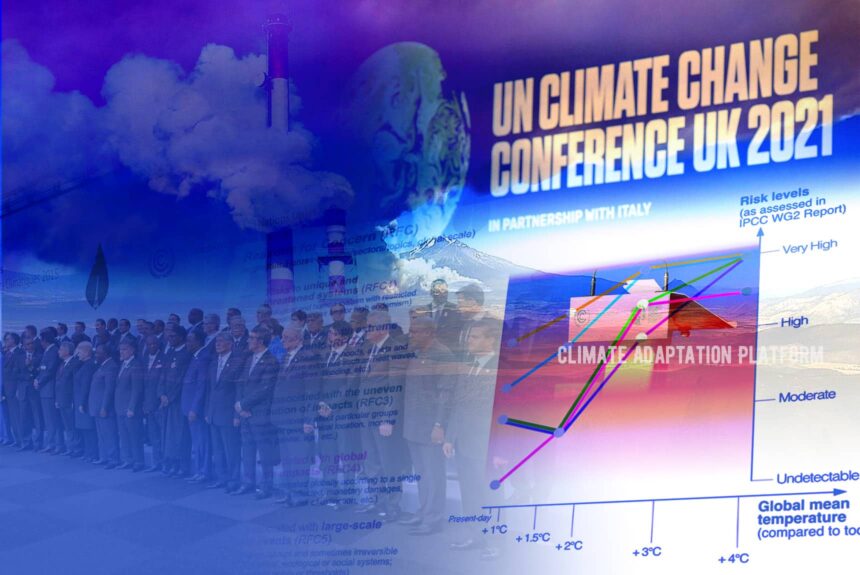The UN report came out just two weeks before the COP27 climate change summit in Sharm el-Sheikh, Egypt. It says that the countries’ climate action plans remain insufficient to limit global temperature rise to 1.5 degrees Celsius.
According to the report, the combined climate pledges of 193 Parties under the Paris Agreement could put the world on track for around 2.5 degrees Celsius warming by the end of the century.
This temperature rise crosses the threshold of 1.5 or 2 degrees Celsius global warming set by the 2015 Paris Agreement. Beyond this point, scientists say that catastrophic climate impacts will occur and significantly increase.
The document also shows current commitments will increase emissions by 10.6% by 2030 compared to 2010 emission levels. This is an improvement over last year’s assessment, which found countries were on a path to increase emissions by 13.7% by 2030, compared to 2010.
Last year’s analysis showed that projected emissions would continue to increase beyond 2030. However, this year’s analysis shows that while emissions are no longer rising after 2030, they are still not demonstrating the rapid downward trend science says is necessary this decade.
Of the 193 parties who submitted their nationally determined contributions (NDCs) at last year’s COP in Glasgow (COP26), only 24 parties have submitted a new or updated climate plan after COP26, despite all of them agreeing to revisit and strengthen their climate plans say Simon Stiell, Executive Secretary of the UN Climate Change.
UN Chief Antonio Guterres commented on the report, “Global and national climate commitments are falling pitifully short,” adding that “We are headed for a global catastrophe” (UN report, 2022).
Guterres talking to the BBC, says, “There has been a tendency to put climate change on the back burner” and “If we are not able to reverse the present trend, we will be doomed.”
He says that the current global problems, such as inflation, Russia’s invasion of Ukraine, and the high energy and food prices, distract governments. But the UN chief insisted that the leaders should not abandon key goals, which include keeping the global temperature rise to 1.5 degrees Celsius and “bringing back climate change to the centre of the international debate”.
The UN report coincided with the World Meteorological Organization (WMO) report revealing that atmospheric levels of the three main greenhouse gases – carbon dioxide, methane and nitrous oxide- all reached new record highs in 2021.
This finding is yet another stark warming of the climate change’s threat. The report says that methane concentrations in 2021 also have seen their biggest year-on-year jump since systematic measurements began nearly 40 years ago.
The current warming trends exceeding the limit set Paris Agreement of 1.5 C by mid-century and exceeding 2 C towards the end of the century, despite the strengthening of emissions reduction, means that the world is facing imminent widespread, substantial, and potentially irreversible risks from climate change, and highlights the need for climate adaptation.
Adaptation is happening worldwide, but there is little evidence of how effectively the actions reduce the risk. Energy Post article shows the results from the global assessment of climate adaptation for the IPCC 6th Assessment (AR6) from Working Group II report:
- First, adaptation-related responses are undertaken in all regions and sectors;
- Second, the vast majority of responses are reported at the local level (by households and individuals, as well as local governments), particularly in farming regions and large urban areas;
- Third, adaptation responses are mainly behavioural (e.g., improvement of homes, changes in crops/livestock or economic activity) rather than technical and/or infrastructural (e.g. in the water sector) and institutional;
- Last, most documented adaptation responses are reported in Africa and Asia to address food- and poverty-related issues.
According to the article, the Working Group II report remains uncertain whether we are on track for adaptation or on a pathway towards maladaptation which will have some implications for policy and science, which includes: more scientific research to assess the effectiveness of adaptation-related measures and if it reduces risks, establishes an international initiative to track adaptation progress globally, prepare to deal with residual risks – risks that continues to increase with continuous global warming even with the most ambitious adaptation measures and adaptation limits.
It mentions that adaptation policies also need to prepare to integrate systemic risk (i.e. cascading, compounding and transboundary across sectors, jurisdictions and populations) from climate hazards and related responses, both within and across borders.
For further information, please read,



Leave a Reply